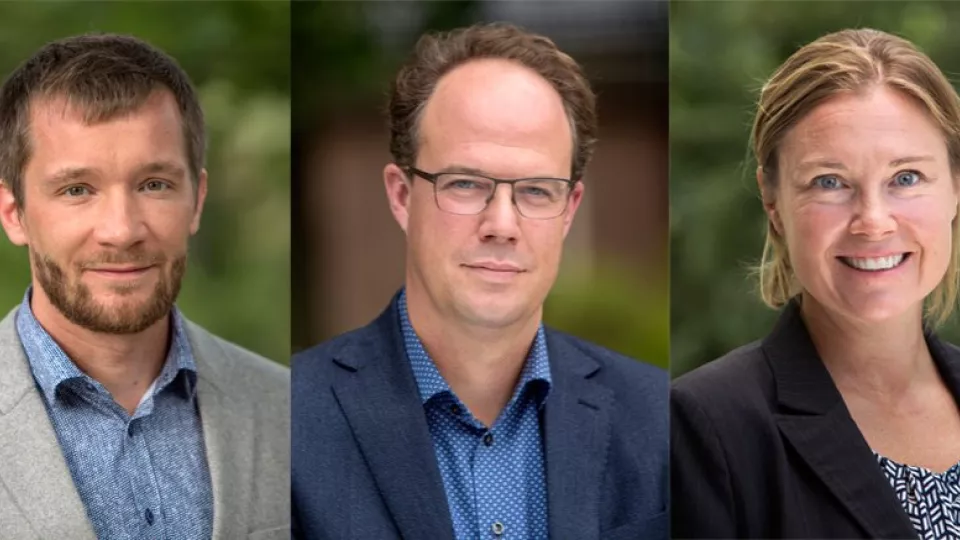The Knut and Alice Wallenberg Foundation has appointed 24 young and prominent researchers as Wallenberg Academy Fellows. The appointment involves a research grant of SEK 5–14 million per researcher for a period of five years. Three of the 24 researchers are currently working at Lund University: microbiological ecologist Johannes Rousk, historian Johan Östling and biomedical engineer Hanna Isaksson.
Microbes control carbon dioxide emission from the soil
Johannes Rousk is a senior lecturer at the Faculty of Science’s Department of Biology. As a Wallenberg Academy Fellow, he and his team will investigate how microorganisms in the soil control the global carbon cycle.
The microbes are able to use the carbon in soil to create energy through respiration in the cells; they can also form biomass to grow. The distribution between energy and biomass determines whether the carbon is released into the atmosphere or bound in the ground.
“Finding out more about this factor is key if we are to understand whether our ecosystems lower or increase carbon dioxide emissions into the atmosphere”, says Johannes Rousk.
He and his research team are searching for answers to whether, and if so how, the microorganisms in soil adapt to environmental changes in the form of global warming and drought. And if the microbes adapt, does it lead to lower or higher carbon dioxide emissions?
To study the consequences of increased temperatures and drought, the team is conducting field experiments in widely different locations: outside Abisko in northern Sweden, in Ethiopia, in Australia and on the east coast of the United States.
For Johannes Rousk, the appointment involves a grant of SEK 1.5 million per year, over five years. When describing what the grant means to him, he emphasises the security that the funding will provide to his research team of eight junior researchers. He also says that it will enable a couple of new recruitments later on.
“The size of the grant gives me the opportunity to focus on my overall research goal. A colleague of mine described it as a ‘North Star goal’ – a target that helps you navigate. Although my North Star goal sounds easy, it can only be approached, never reached. It’s about being able to see the world from the microorganisms’ perspective”, he says.
Knowledge is transformed and reshaped
What happens to knowledge when it circulates and is popularised in society? How is knowledge transformed when it moves between different contexts?
In a society of fake news and fact resistance, research in the history of knowledge has become clearly relevant. In his project, Johan Östling, associate professor at the Department of History at the Faculties of Humanities and Theology, will explore how knowledge in the humanities is transformed as it moves and circulates in different arenas of society – within education, literature and the public. What happens to knowledge after it has been published? How is it used and reshaped? What makes it significant to society at large?
“Knowledge is not transferred as a sealed package – it always ends up in new contexts”, says Johan Östling. “I want to identify the system behind the circulation”, he continues.
He will focus on the pre-digital period between the 1960s and early 1980s in Sweden and West Germany, as this period represents the old media society, with a few established publications and national newspapers, radio and television channels.
“In order to understand how it works today, we must also know how it worked yesterday”, says Johan Östling. “Here, you’ll find many conceptions and memories but not a lot of research.”
Among other things, he will study what role researchers have played as knowledge agents in the public, and how the position of qualified non-fiction on the book market has changed. The comparison between Sweden and Germany will contribute to a more precise understanding of what knowledge circulation entails.
With this funding, he hopes to continue to develop the knowledge-history environment that he and his colleagues are in the process of building in Lund. The history of knowledge and research on the importance of humanities in modern society are two growing and vibrant international fields.
Improved healing of torn Achilles’ tendons
Half of the people who suffer from a torn or ruptured Achilles’ tendon never regain full function afterwards. More knowledge of how and how much weight should be put on the tendon will help more people slowly but surely gain full recovery.
At least, this is the hope behind a new research project in which Hanna Isaksson, associate professor of biomedical engineering and new Wallenberg Academy Fellow, will get to the bottom of the issue.
Together with her research team, she intends to look into the innermost parts of the Achilles’ tendon, through measurements at MAX IV, among other things. These measurements will allow her to see how different structures in the tendon are stretched and how water flows when weight is placed on the tendon in different ways.
“If we can understand what happens at the cellular and molecular levels, it increases our chances of understanding what mechanisms can restore the mechanical function of the Achilles’ tendon”, says Hanna Isaksson.
The observations will lay the foundation for calculation models that, in the long term, may facilitate the design of suitable treatment programmes within healthcare.
Hanna Isaksson and her research team have several years of experience in this area of research, situated in the field of biomechanics in which mechanical laws are used to study the impact of various forces on living tissue. Hanna Isaksson previously specialised in osteoporosis to identify patients with high risk of osteoporosis fractures, among other things.
